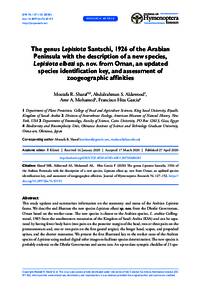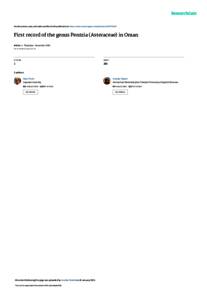Document
The genus lepisiota santschi, 1926 of the Arabian Peninsula with the description of a new species, lepisiota elbazi sp. nov. from Oman, an updated species identification key, and assessment of zoogeographic affinities.
Identifier
DOI: 10.3897/jhr.76.50193
Source
Journal of Hymenoptera Research. v. 76, p.127-152
Contributors
Country
Bulgaria.
Publisher
Pensoft Publishers.
Gregorian
2020-04-27
Language
English
English abstract
This study updates and summarizes information on the taxonomy and status of the Arabian Lepisiota fauna. We describe and illustrate the new species Lepisiota elbazi sp. nov. from the Dhofar Governorate, Oman based on the worker caste. The new species is closest to the Arabian species, L. arabica Collingwood, 1985 from the southwestern mountains of the Kingdom of Saudi Arabia (KSA) and can be separated by having fewer body hairs (two pairs on the posterior margin of the head, two or three pairs on the promesonotum and, one or two pairs on the first gastral tergite), the longer head, scapes, and propodeal spines, and the shorter mesosoma. We present the first illustrated key to the worker caste of the Arabian species of Lepisiota using stacked digital color images to facilitate species determination. The new species is probably endemic to the Dhofar Governorate and seems rare. An up-to-date synoptic checklist of 21 spe-cies representing the Arabian Lepisiota Santschi, 1926 is emended based upon the most recent literature in ant systematics. Five species are excluded from the Arabian Lepisiota fauna, L. arenaria (Arnold, 1920), L. erythraea (Forel, 1910), L. incisa (Forel, 1913), L. sericea (Forel, 1892a), and L. simplex (Forel, 1892) for issues related to previous species misidentification. Lepisiota carbonaria (Emery, 1892) is proposed as a senior synonym of L. depilis (Emery, 1897) syn. nov. The faunal composition of Lepisiota species recorded from the Arabian Peninsula can be divided/delineated into two main groups according to their zoogeographical relationships; (1) Afrotropical (11 species-~52.38%); (2) Palearctic (10 species-~47.62%) elements whereas eight species (~38%) are Arabian endemics.
ISSN
1070-9428
Resource URL
Category
Journal articles


